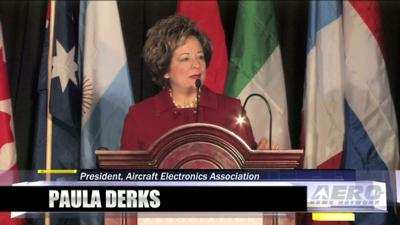Tue, Oct 30, 2012
Proposal Has Damaging Effect On More Than Just Part 121 Air Carrier Repair Stations
The Aircraft Electronics Association is speaking out against the FAA's notice of proposed rulemaking (NPRM) for Part 145 repair stations at the 65th annual National Business Aviation Association (NBAA) Meeting & Convention, Oct. 30-Nov. 1 in Orlando, FL. "This proposal makes wholesale changes to the avionics industry with damaging and costly repercussions," said Paula Derks, AEA president. "At a time when avionics and electronic systems are interfaced with every mechanical system on the aircraft, the FAA proposes to remove radio and instrument ratings and allow airframe-rated repair stations to work on electronics without adequate oversight.

"The rule proposes a 24-month transition period to reissue new certificates, and there is no implementation period. With the current lack of FAA workforce and sequestration initiatives, how will the agency approve and reissue certifications to 4,000 repair stations in a 24-month period? Without the FAA's ability to service an application in a timely manner, businesses will close.
"Contrary to the FAA's claim, this proposal does not reflect current repair station aircraft maintenance and business practices, or advances in aircraft technology. It simply does not recognize avionics as a profession. These changes would not modernize the regulations to keep pace with current industry standards and practices. Rather, they would roll modern aviation back to the days of round motors and tube radios from the 1930s."
In addition, Ric Peri, AEA vice president of government and industry affairs, stated "The AEA has received second-hand information that various user groups, as well as certain FAA inspectors, have incorrectly assumed and promoted that the Part 145 NPRM proposal only applies to repair stations that cater to Part 121 air carriers. This is not true and is disturbing. This proposal applies to all repair stations regardless of its customer bases."
The AEA's major concerns with this proposed rule are as follows:
- Cost to Comply: The cost to comply and transition to this new rule will impose a huge monetary investment on repair stations. This proposed rule requires revision and approval of all three repair station manuals, as well as developing and managing a list of capabilities. The FAA is not accounting for the man-hours needed for a repair station to revise its manuals and create capability lists.
- Lack of Time to Transition: The rule proposes a 24-month implementation period to reissue new certificates for all repair stations. With the current lack of FAA workforce and sequestration initiatives, how will the agency provide the resources needed to approve and reissue certifications to 4,000 repair stations in a 24-month period? If a repair station certificate is not reissued within the 24-month time period, the previous certificate is no longer valid and businesses will not be able to operate as a Part 145 repair station.
- Avionics Profession Loses Its Identity: Under this proposal, the system of ratings would be reduced from eight ratings to five ratings. The ratings definitions would be revised to indicate the type of work that a repair station is authorized to perform. But, it also removes radio and instrument ratings and allows airframe-rated repair stations to repair and alter radios and instruments without any specific ratings or obvious qualifications.
- Costly & Time-Consuming Capabilities List: This proposal does not specifically require a capability list, but does require a listing of capabilities for all repair stations. This is a potentially marked change for repair stations with class ratings that do not currently have a capability list of the items they maintain. Also, capabilities list, or list of capabilities, will be subject to a line-item review every 24 months. This requirement will force repair stations to hire additional staff to maintain these lists.
- No Mobility: Each certificated repair station must provide and maintain suitable permanent housing for the facilities, equipment, materials and personnel consistent with its ratings. It appears this provision would prohibit mobile operations. Currently, the regulations allow for a permanent "fixed location" but not permanent housing. In addition, the proposal would not allow "space available" contracts with landlords.
AEA has more information about the NPRM at their booth at the NBAA convention this week.
More News
Light Gun A handheld directional light signaling device which emits a brilliant narrow beam of white, green, or red light as selected by the tower controller. The color and type of>[...]
"The journey to this achievement started nearly a decade ago when a freshly commissioned Gentry, driven by a fascination with new technologies and a desire to contribute significan>[...]
Aero Linx: JAARS, Inc. For decades now, we’ve landed planes on narrow rivers and towering mountains. We’ve outfitted boats and vehicles to reach villages that rarely se>[...]
"Our driven and innovative team of military and civilian Airmen delivers combat power daily, ensuring our nation is ready today and tomorrow." Source: General Duke Richardson, AFMC>[...]
Aircraft Conflict Predicted conflict, within EDST of two aircraft, or between aircraft and airspace. A Red alert is used for conflicts when the predicted minimum separation is 5 na>[...]
 ANN's Daily Aero-Term (04.20.24): Light Gun
ANN's Daily Aero-Term (04.20.24): Light Gun Aero-News: Quote of the Day (04.20.24)
Aero-News: Quote of the Day (04.20.24) ANN's Daily Aero-Linx (04.21.24)
ANN's Daily Aero-Linx (04.21.24) Aero-News: Quote of the Day (04.21.24)
Aero-News: Quote of the Day (04.21.24) ANN's Daily Aero-Term (04.21.24): Aircraft Conflict
ANN's Daily Aero-Term (04.21.24): Aircraft Conflict



